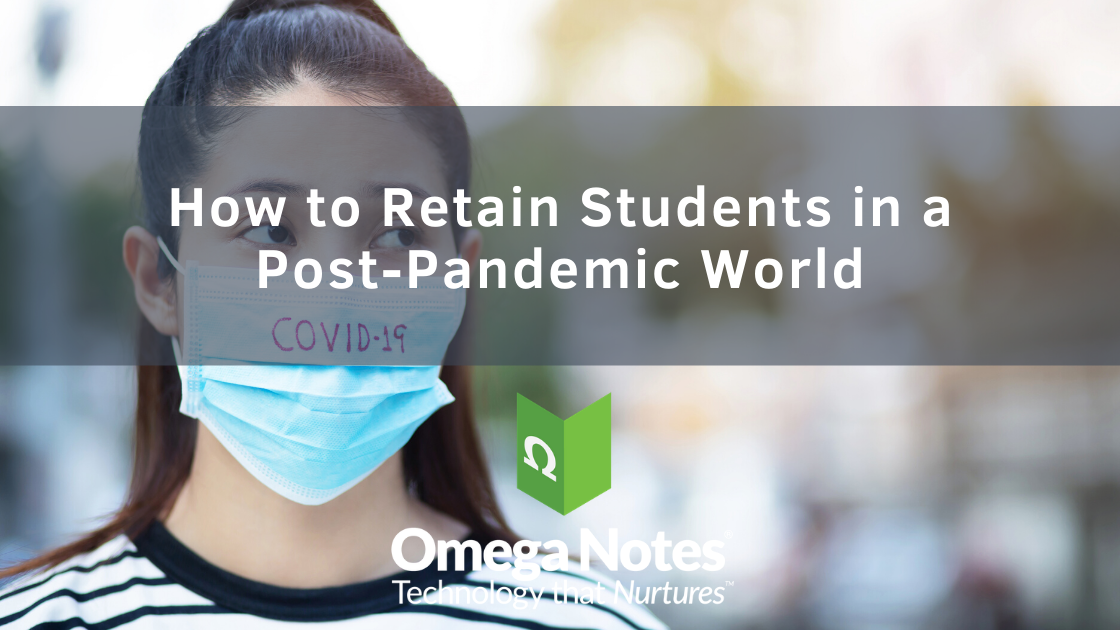Student retention has long been a challenge facing higher education, and COVID-19 has only exacerbated the struggle of keeping students enrolled. Lost income negatively impacts a university’s ability to carry out its mission, but even worse is the tragedy that many of these lost students will never realize their full potential without a complete education. In 2019, on average 26 percent of students postponed or stopped their education according to the NSC Research Center. The long-term consequences of COVID-19 are still unknown, but most sources predict that universities will see at least an additional 20 percent loss in their student body.
This loss will be devastating. COVID-19 has unearthed deep underlying issues institutions, educators, and students face which will be ever-present in a post-pandemic world. Katherine Streeter said it best in her Chronicle of Higher Education article, How Your College Can Survive the Pandemic, “The problem goes beyond the immediate need to manage through Covid-19; Rome is burning”. How can you stop this inferno from consuming your university’s future?
One fact is clear; historically universities that invest in innovative solutions are those that retain students and thrive in times of uncertainty. No one solution can address these challenges, and there are dozens of technology companies that promise results for an institution’s bottom-line. However, over 90 percent only offer piecemeal products delivering facts administrators are already keenly aware of. Collaboration and education quality challenges caused during the sudden transition online forced by COVID-19 is a perfect demonstration of why not every EdTech tool is a must-have. To address retention, tools need to be comprehensive, approachable, and affordable. Here is what to look for in a retention solution.
Engage Students
Often retention solutions are nothing more than a data aggregation platform used to report facts and figures an institution is already collecting. While there is value in identifying trends in data, these solutions fall short in addressing the underlying issue affecting retention. Rarely are retention challenges made clear with broad problem identification. Students leave institutions for well-documented reasons, some of which are controllable. Above all else, student engagement stands out as a core retention metric that is very much within an institution’s control.
To be successful, the student equation needs to be a fundamental piece of an analytics platform. Data aggregation needs to go beyond reporting a problem and be a primary source of gathering actionable data. Ask yourself, in order to mitigate the risk of lost retention, is the data we are gathering and the trends we are observing inclusive of proven student learning satisfaction analytics? And, because we want a positive impact on the student body, is it a technology students can actually use as part of their daily learning both on- and off-campus?
There are few solutions that offer both a powerful analytics interface for monitoring student learning layered with an engagement solution for keeping students collaborating and involved in their coursework. In order to improve your retention rate, are you ready to elevate the big data strategy at your institution?
Improve the Experience
While it may sound like “improve the experience” is so obvious it is not worth saying, I am constantly surprised at how often this basic fact is ignored. Ask yourself, do students genuinely enjoy the technology experience at your campus? All too often technology infrastructure challenges are crowded by business needs over those of student learning. It is easy to get lost in the process of maximizing efficiency. The irony is that this disjointed approach to improve the bottom-line can negatively impact financial progress as students frustrated with the user experience are those that find themselves disengaged. These disengaged students are the first in line to leave your institution.
Of course, it is necessary to have technology focused on operational effectiveness, but be wary that this does not detract from other priorities. As the line between “education” and “education technology” blurs, the user experience becomes even more essential. Take a page from Apple’s book; making an interface that is intuitive, responsive, and creates value leads to user satisfaction. Do not put the user experience second. Clearly there are other significant challenges in education, such as equitability, that Apple does not face. This is still no excuse to discount your student’s user experience. In a technology-driven world filled with digital natives, priorities need to be reevaluated, and higher education needs to contend with the fact that they must deliver the experience students need.
It is important to note that improving the user experience does not mean more technology. Often it means dramatically improving existing platforms or eliminating complicated and worn solutions with new and innovative products. Layering technology into an increasingly complicated stack did not work in the past and it will certainly not work in the future. Be on the lookout for ways to eliminate complexity.
Foster Communities
The need for effective learning communities is more important now than it ever has been. While it was heartening to see such a concerted effort to transition learning online, the pivot to distance learning was far from perfect. At the beginning of the COVID panic learning communities were all but abandoned. The result has been a sense of isolation and depression that has the highest percentage of students to date choosing to take a gap semester for the Fall semester.
The transition online left a lot of students wondering, “What’s the point of going to college in a world where all the information I need is freely available at my fingertips?” I want to clarify that this is not a constructive or well thought out argument. But this rising concern amongst students still does not change the reality that this is a sentiment faced by many students, and you should be able to empathize with them.
These students were suddenly asked to abandon their campus network and community that administrators and professors have been cultivating for years. The dorms, clubs, libraries, and serene beauty of the university campus was gone in an instant. Students felt removed from their professors, their fellow students, and other campus services. In most cases the substitute offered was little more than an LMS discussion board, video conferencing, and an email client. Clearly this is no way to foster a community of learning.
There are a select few social learning solutions out there that are designed specifically to motivate students to connect with one another and their professors. Equally important is the fact that these solutions help administrators keep intune with student sentiment and conversations. While social learning platforms will not entirely substitute the campus environment, they will keep the community alive and allow your students to have their voice heard. Reconnecting students back to your university environment will be paramount if you expect to keep them at your institution.
Student, parent, and institutional surveys indicate that social learning will be all but required in our post-pandemic world. Even when students return to campus, social-learning platforms will be the answer to many of the questions on the minds of everyone involved in the educational community. How will institutions service international students or even out of state students? Will students be forced to return if they are afraid of getting sick? What about students who need to care for family members in the midst of economic duress? Social learning offers a tool to keep students engaged in the learning community regardless of their location. I guarantee you that a social learning tool is what most administrators wish they had implemented prior to COVID-19.
Gain Actionable Insights
While I was critical on technology focused on data aggregation, that was not to discount the significance of learning analytics. We live in a world of big data that has presented challenges unto itself. While it is easy to collect data, it is far more challenging to translate that data into useful information and actionable insights. There are three key challenges with big data; velocity, volume, and variety. Most platforms struggle with all three, but velocity is often an understated component.
Velocity is essentially a measure of how quickly data can be gathered and compiled into information in a relevant manner. The unfortunate fact in education is that this data is often not delivered fast enough. Real-time analytics give an institution the ability to be proactive with their education rather than reactive. When an institution understands where and how students are struggling, they are better positioned to retain that student by catering to their learning needs during the course rather than responding after a negative event.
The Bottom Line
No one chose for this virus to fundamentally interrupt education, and it is impossible to fully control the situation. With that said, indecision is a decision unto itself. While higher education’s response to COVID-19 thus far should be commended, there is still much to do to improve the post-pandemic teaching/learning experience. Students need professors and administrators to be forward-thinking in their technology selections. Technology is not the solution to every problem we face, but it will play a fundamental role. Institutions who are unwilling to deliver better technology solutions and improve existing infrastructures will be those who students abandon. Will your institution continue fulfilling its mission, or will you be frozen in uncertainty as others innovate around you?
Matthew Compton-Clark
Education Technology Specialist and Operations Manager at Omega Notes






Leave A Comment